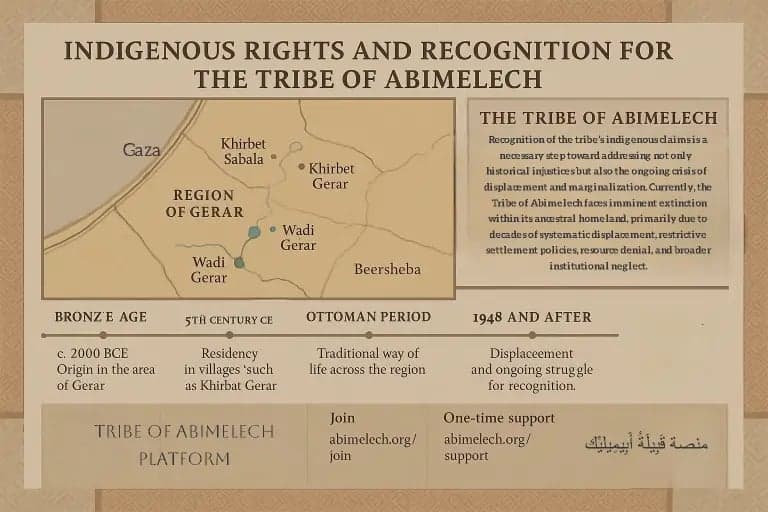 The Hasanat Abu Mu’ailiq, an indigenous Bedouin tribe from Beersheba, now face cultural genocide and the threat of extinction on sacred ancestorial territory
The Hasanat Abu Mu’ailiq, an indigenous Bedouin tribe from Beersheba, now face cultural genocide and the threat of extinction on sacred ancestorial territory
Background
The Hasanat Abu Mu’ailiq tribe, known on the Abimelech Platform, identifies itself as a Canaanite Bedouin tribe whose members historically inhabited a corridor stretching from Beersheba (Bi’r as‑Sabaʿ) to Gaza. According to tribal oral history and Arab historians and encyclopedias, our ancestry in Palestine traces back to at least four millennia to King Abimelech of Gerar. The tribe elders recount our ancestors formed a covenant of coexistence with the Prophet Abraham at Bi’r as‑Saba, later renewed with the Prophet Moses, and united Canaanite Palestinians and early Jewish tribes that immigrated to Canaan. Our historic seat is Khirbet Umm Jarrar and Khirbet Abu Mua'liq, located west of Beersheba and east of Gaza, and we emphasize that our identity predates Arab and Jewish nationalism.
This ancestral continuity is not only preserved in historical texts but also in living memory. Nesma Abu Mu’ailiq, now 96 years old, recalls being expelled from Khirbet Abu Mu’ailiq in 1948 and again displaced from Gaza in 2023. Her testimony bridges generations, showing how the same families who cultivated land in Beersheba for thousands of years now endure repeated exile. Such oral histories confirm that the tribe’s identity is not abstract but lived, transmitted, and endangered across lifetimes.
Indigenous recognition and land rights
The Bedouin communities of the Negev/Naqab desert have inhabited and maintained a presence in the region since at least 5000 BC. We have long practiced a customary land and water management system, but Israeli planning policies have forcibly transferred our families into planned towns and denied us access to our sacred wells and ancestral lands. We continue to urge the State of Israel to recognize Bedouin water and land rights and align policies with international human‑rights instruments.
The Minority Rights Group (MRG) describes the Bedouin as an indigenous people of the Negev, numbering about 200,000; an estimated 80,000–90,000 live in 35 unrecognised villages under constant threat of eviction. Israeli authorities refuse to recognize these villages or the Bedouins’ indigenous status, leading to ongoing land confiscations, house demolitions and denial of basic services. These findings suggest that the Hasanat Abu Mu’ailiq, as a Bedouin tribe from the Beersheba–Gaza corridor, share the same indigenous characteristics and face similar denial of rights.
International law reinforces these claims. The United Nations Declaration on the Rights of Indigenous Peoples (UNDRIP) affirms the right of indigenous peoples to maintain their spiritual relationship with ancestral lands and to be protected from forced removal. The Rome Statute of the International Criminal Court further defines forcible transfer and persecution as crimes against humanity. The denial of recognition to Bedouin tribes like the Hasanat Abu Mu’ailiq therefore violates not only moral obligations but binding international standards.
Connection to Gerar and the Beersheba–Gaza corridor
 The Hasanat Abu Mu’ailiq, an indigenous Bedouin tribe from Beersheba and Gaza for over 4,000 years, embody millennia of pastoral life and cultural continuity. Today their ancestral way of life is still endangered by the ongoing 77-year genocide and forced displacement from ancestorial tribal territories, denial of recognition, and the looming threat of extinction.
The Hasanat Abu Mu’ailiq, an indigenous Bedouin tribe from Beersheba and Gaza for over 4,000 years, embody millennia of pastoral life and cultural continuity. Today their ancestral way of life is still endangered by the ongoing 77-year genocide and forced displacement from ancestorial tribal territories, denial of recognition, and the looming threat of extinction.
Historical and archaeological studies locate Gerar in the Nahal Gerar basin. Excavations at Tel Haror/Tell Jemmeh and ruins at Khirbet Umm Jarrar correspond to the biblical Gerar; Byzantine, Victorian and modern surveys record continuity in the toponym (Jarrar/Gerar) and document Bedouin communities living in the area through the modern era. While these studies seldom mention the Hasanat Abu Mu’ailiq by name, apart from many Arab studies that do, they all confirm that a Bedouin (indigenous) population historically inhabited the corridor between Beersheba and Gaza.
Beyond archaeology, the tribe’s cultural practices, oral poetry, water‑sharing customs, religious pilgrimages and seasonal migrations embody a continuity of Canaanite traditions. These practices are not relics of the past but living systems of knowledge that sustain both community identity and ecological balance. Their erosion through genocide and displacement represents not only a human tragedy but the loss of an indigenous knowledge system tied to the Holy Land for millennia.
Threat of extinction and displacement
The combined effects of Israeli military operations, forced displacement and administrative policies pose an existential threat to indigenous Bedouin communities. Since October 2023, Israeli forces have carried out repeated airstrikes on Gaza, destroyed homes, hospitals and farmland, and imposed a siege that displaced more than 90 percent of Gaza’s population. Concurrently, the Palestinian Authority (PA) under the leadership of the self-appointed dictator Mahmoud Abbas and his family launched armed operations in the West Bank which have contributed to several deaths and several hundred imprisoned.
The genocide of Palestinians during 2023-2025 highlights a significant blow to the tribe's continuity. Over a third of the 128 deaths that are accounted for at the time of writing are children and adolescents: seven infants and toddlers aged 0–2 (5.5%), twenty-one children aged 3–12 (16.4%), and fourteen teenagers aged 13–17 (10.9%). The loss of these forty-two minors (32.8%) removes a crucial part of the tribe’s future; students, apprentices, and future caregivers. Thirty-six young adults aged 18–29 (28.1%) and forty-two adults aged 30–59 (32.8%) make up the majority of the deceased (60.9% within the 18–59 working-age group). This group supported households, funded education, and handled daily responsibilities; their absence leads to a predictable collapse in income, guardianship, and education access for dependents. Five elders aged 60+ (3.9%) and three additional victims not yet accounted for (2.3%) complete the picture. In essence, the tribe has lost its future potential, current livelihoods, and cultural custodians.
These figures represent apprentices, caregivers, and cultural transmitters. The loss of children severs the future, the loss of working adults collapses the present, and the loss of elders erases memory. Together, this pattern constitutes what international law describes as “deliberately inflicting conditions of life calculated to bring about the destruction of the group in whole or in part. - Bajis Hasanat Abu Mu'ailiq
Human‑rights observers note that the Bedouin in the Naqab and by extension in Gaza continue to face home demolitions and forced transfers: around 80,000–90,000 Bedouins live in unrecognised villages at constant risk. Under the combined Israeli and PA strategies of displacement and oppression, Bedouin tribes such as Hasanat Abu Mu’ailiq risk losing more of their land, culture and physical safety, posing a threat of cultural and physical extinction.
Suppression of indigenous voice by the Palestinian Authority
The Tribe of Abimelech Platform argues that the PA restricts their ability to mobilise both inside and outside Palestine. Independent reporting confirms that the PA has violently suppressed political opposition. In December 2024 the PA banned Al Jazeera news broadcasts and cut water and electricity to several refugee camp housing indigenous populations to pressure residents; Mahmoud Abbas's forces used snipers and armoured vehicles to arrest activists and journalists. Reporters Without Borders documented that nine journalists were detained or questioned and forced to pledge not to appear on Al Jazeera. Such repression inhibits indigenous communities from publicly advocating for their rights or sharing evidence of abuses, thus contributing to their marginalisation.
This suppression mirrors a broader pattern of silencing indigenous voices worldwide, where post-colonial states deny recognition to avoid obligations. For the Hasanat Abu Mu’ailiq, the PA’s repression compounds the existential threat already posed by Israeli displacement, leaving the tribe squeezed between external occupation and internal authoritarianism.
Conclusion
The Hasanat Abu Mu’ailiq tribe situates itself as a direct descendant of the ancient Canaanite polity at Gerar Palestine and asserts an unbroken connection to the Beersheba–Gaza corridor. Independent evidence confirms that Bedouin communities in the Naqab and southern Palestine are indigenous peoples with long‑standing ties to the land and have been subjected to systemic demolition, displacement, and denial of recognition. Since October 2023, the combined effect of Israeli military operations and the PA’s suppression of dissent has escalated the risk of cultural extinction for tribes like Hasanat Abu Mu’ailiq. While the tribe’s own narratives emphasize unity and mediation between peoples, the ongoing genocide which has persisted for over 77 years, threaten to erase their presence from ancestral lands. Yet the Hasanat Abu Mu’ailiq reaffirm their sacred oath of peace, carried across four millennia, and call upon the international community to recognize their indigenous status, protect their cultural heritage, and ensure their survival. To lose this tribe is to lose a living covenant with the prophets, built on coexistence and grounded in the soil of Canaan.





